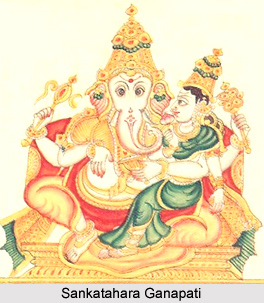 Sankatahara Ganapati, also known as Sankata Hara Ganapati or Sangadahara Ganapati, is one of the thirty two forms of Lord Ganesha. He is represented in the Tantric form as well as in the celibate form. He is considered as the remover of sorrow. Lord Ganesha is the son of Lord Shiva and Goddess Parvati (Uma). Sankatahara Ganapati is portrayed in red complexion and adorned with blue garments. In this form, the elephant-headed god is seated on a red lotus throne and is accompanied by his consort (Shakti). The Goddess is seated on the left lap of Ganesha. She is adorned in green garments and carries a blue flower in her hand.
Sankatahara Ganapati, also known as Sankata Hara Ganapati or Sangadahara Ganapati, is one of the thirty two forms of Lord Ganesha. He is represented in the Tantric form as well as in the celibate form. He is considered as the remover of sorrow. Lord Ganesha is the son of Lord Shiva and Goddess Parvati (Uma). Sankatahara Ganapati is portrayed in red complexion and adorned with blue garments. In this form, the elephant-headed god is seated on a red lotus throne and is accompanied by his consort (Shakti). The Goddess is seated on the left lap of Ganesha. She is adorned in green garments and carries a blue flower in her hand.
In this form, Lord Ganesha carries a noose, an elephant goad and a vessel of payasam (sweet dish) in his hands. His main right hand displays the Varada Mudra, which is a type of yoga mudra; while with the main left hand Sankata Hara Ganapati gently embraces Shakti. The devotees of the Hindu god worship this form to attain success and prosperity. Moreover, the Lord removes all sorrows from the lives of His worshippers.
The Sankatahara Ganapati form of Lord Ganesha is worshipped by the recitation of the Sankata Nasana Ganapati Stotram. The devotional hymn is chanted on a daily basis for atleast three times. It is believed the sacred strota removes all problems and sorrows from the lives of His devotees. Meditating on this form of the Lord helps the worshippers to gain wealth and knowledge and to attain salvation or moksha.
This article is a stub. You may enrich it by adding more information to it. You can send your write-up at content@indianetzone.com




















